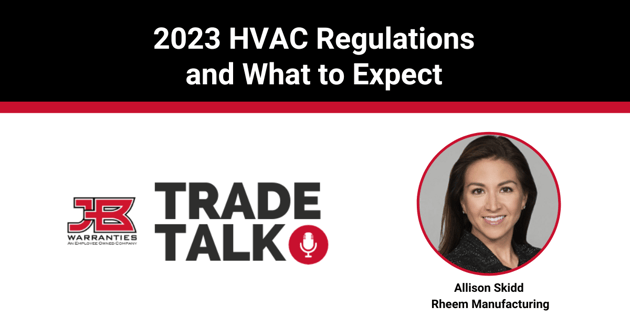
On this episode of Trade Talk, Tommy Cue talks with Allison Skidd the Sr. Manager of Global Regulatory Affairs with Rheem about the upcoming 2023 HVAC regulations. Allison is considered an expert on the regulations and shares her insight on what HVAC contractors can expect.
Here's a breakdown of what you'll learn:
- Discover some of the things Rheem has planned regarding the upcoming regulation changes.
- New test and rating procedures.
- How is the new procedure different from the old one and why did it have to change?
- New regulations by region.
- What should contractors do with existing inventory?
- The future of refrigerants.
- A rundown of the new A2L.
- The AIM Act.
- When flammable refrigerants will be coming to each state.
- US Regulatory Guide for HVAC.
Connect with Tommy and Allison:
Host:
Tommy Cue, JB Warranties
Guest:
Allison Skidd, Rheem
Read the transcript:
Tommy Cue:
Good afternoon. I'm Tommy Cue with JB Warranties, here to do another episode of JB Warranties Trade Talk. I have the pleasure to introduce to you today, Allison Skidd. Hello, Allison. How are you?
Allison Skidd:
I'm fine. How are you, Tommy?
Tommy Cue:
I'm doing fine. Thanks for joining us. We've got some changes coming to the HVAC industry. I was actually talking with Randy Roberts the other day, and he thinks that you guys are in just a fantastic position and, hopefully, leading the pack for some changes coming up in our industry. Tell me, first and foremost, a little bit about what you do for Rheem Manufacturing.
Allison Skidd:
Sure, I'd be glad to, and thanks for having me here. My name, like you said, is Allison Skidd. I lead global regulatory affairs for the air business at Rheem. That covers anything that moves air, really, your air conditioning, heating, heat pumps, refrigeration, and I'm based out of my home in Delaware.
Tommy Cue:
Oh, nice. Up in where it's cool. We're down here in Texas where it's hot.
Allison Skidd:
That's right.
Tommy Cue:
Lot of changes coming. We've got some new efficiency standards. Tell me, in a nutshell, walk me through the 2023 regulatory changes and some of the things that Rheem's going to do and have in place.
Allison Skidd:
Yeah, yeah, absolutely. You may be familiar with the Rheem Regulatory Guide. We published that at the beginning of this year, 2022, and then just published a new version of it with some added information that people were looking for. But what it really outlines is the basics of the 2023 efficiency changes for air conditioning and heat pumps, which right now are around the corner. We've been talking about it for a long time.
Allison Skidd:
Many people know this. The US Department of Energy is implementing an all around efficiency increase. It averages about seven to 10% depending on the equipment type. This is mainly applying here for single phase systems, five tons and below. It's coupled with an entirely new test procedure and ratings procedure that will change the nicknames that we use for efficiency metrics. Our new test method is called Appendix M1, you hear the nickname M1 a lot. That replaces the old Appendix M in the code of Federal Regulations. These new metrics of CR2, EER2 and HSPF2, they'll CR, EER, and HSPF.
Tommy Cue:
And so, the biggest factor, I think you said, is the change and the testing procedure involved to hit the new standard. What is that like? I know that's got to be much more complicated.
Allison Skidd:
Yeah, it has changed. It's not a bad thing necessarily because... And it's a popular question, how is this procedure different than the old one? Why does the rating have to change? Well, it's basically the test procedure is created to be a more accurate representation of how a unit performs in a typical home or residential installation. For ducted systems, for example, you'll have static pressure testing guidelines have changed. For coil only matchups, the watts per CFM are increasing. And so, some other little factors that actually make it more representative, so it should be a better representative of efficiency on how it actually operates.
Tommy Cue:
All manufacturers have been working toward this goal. What they've done is they've kind of restructured the country and given us regional standards, which is more complicated, but it makes some sense. I don't know. Can you walk through the different regulations by region, if you will?
Allison Skidd:
Sure, sure, and you have my sympathies there, being in the south, because you have it a little bit rough going into some of these changes, just like we'll talk about. Having different requirements by region is not necessarily a new concept. We have that in place today. But starting in 2023, there are unique aspects to the regional standards that will affect the states that are in the southeast and southwest of the United States.
Allison Skidd:
And so, the 2023 efficiency requirements from DOE, they apply nationally unless they're superseded by a regional standard. In the north, there is no regional standard. The systems manufactured prior to 1/1/2023, they can sell through. The compliance is based on the date that the system was manufactured and it's relatively straightforward. But, in the south, the regional standards apply, they supersede those national standards. The key difference there is that the compliance is based on the date the system is installed. Our online guide shows that map. It shows which states are in which region, and it'll show that there are higher efficiency requirements, for say, split ACs, and in some cases, package Acs, and points out that the regional standards in the southeast and southwest are effective based on that date of installation.
Tommy Cue:
When you say 2023, contractors, a lot of large contractors, stuck a lot of inventory. What would contractors' best case scenario be, from Rheem's standpoint, to do with their existing inventory?
Allison Skidd:
Yeah. Well, one thing to know is that when you talk about heat pumps, heat pumps, none of the regional standards apply to heat pumps. Only the national standard applies. That means that if you have something that's rated to the old metrics that was made before 1/1/2023, you can continue to sell that, install that, indefinitely in all states. And so, as long as it was compliant on the day it was produced, you can keep installing your heat pumps there.
Allison Skidd:
The biggest question I get is, especially in the South, what do I do with my existing inventory of my ACs that are applicable to this regional requirement? The latest guidance that we have from the Department of Energy states that the least efficient coil only rating needs to be used in figuring out whether you can still use that old piece of equipment and install it. What does that mean? How do I know? The least efficient rating is going to be on that yellow energy guide label. Everybody's familiar with the yellow energy guide label. The lowest number on that, if there's a range on it, you need to look at the lowest number on that and that needs to be at or above the new minimum requirements on a conversion basis.
Allison Skidd:
Now, remember, your old label's going to CR, and now we're going to CR2. You're going to have to look up what the conversion is from one to the other. Now, if you're talking about systems less than 45,000 B2U per hour, that minimum is going to be 15 CR, that equals 14.3 CR2. You're going to look at something greater than 15 CR has to be the lowest one on the range on that energy guide label. Again, look for more information on our regulatory guide about some of these specifics. But if the energy guide label shows you're in that range, then that is compliant to be installed after 1/1/2023.
Tommy Cue:
Okay, okay. It's going to be a little bit of a change. That's okay. Not only are the testing standards changing, but many manufacturers are looking at alternative refrigerants.
Allison Skidd:
Yes.
Tommy Cue:
We're all familiar with the old R22, and then we went to the 410A. Can you share with me what Rheem's thinking on refrigerants for the future?
Allison Skidd:
Sure, sure, yeah. And so, we've been here about this one for a while as well. We know that California, for a while, was fixing to go to a lower GWP limit for air conditioning and refrigeration but then, in 2020, we got the AIM Act, which is the American Innovation and Manufacturing Act. That was signed into law, and that authorizes the US EPA to structure a 15 year phase down of hydrofluorocarbons or HFCs. A lot of people have heard of Kigali, and the US has not ratified Kigali yet. But, essentially, the AIM Act follows that same exact phase down of HFCs on the same schedule, so it's almost the same effect as the Kigali amendment.
Allison Skidd:
And so, the EPA will create rules for the different sectors that use refrigerants, such as refrigeration, such as air conditioning, and they will let us know what the limits are. Now, this one should not be a surprise because we have long agreed on what that limit should be for air conditioning. And so, we expect there to be a limit of 750 GWP, that's global warming potential, by 2025 for air conditioning.
Tommy Cue:
Got it.
Allison Skidd:
The EPA will be coming out with a rule on that. We're expecting it very soon, probably later this year, before the end of the year, we should see a draft rule on that.
Tommy Cue:
Fantastic. I was with a contractor success group the other day, and they were all talking about the A2Ls and the new refrigerant, and it's going to be highly explosive. There's some perceptions out there. Give me a rundown on the new A2Ls, if you would please?
Allison Skidd:
Yeah, sure, sure. Right. 750 GWP limit means no more 410A. We know that much. And so, the replacements that are compatible with systems that are most similar in their profile to 410A that are below 750, do have some degree of flammability, like you said. They're not explosive. That's a different aspect, but they are mildly flammable. That's an ASHRAE classification called A2L. That's a lot different than, say, propane, which is an A3 flammable, much more higher flammability. This, we've got the A2L flammables, and the top two candidates to replace 410A in air conditioning are 454B and R32. Rheem has been designing with 454B for most of the residential ducted designs, and that's what we'll be planning to use come 2025.
Allison Skidd:
But the flammability, people need to be aware of it and they need to be prepared for it and trained for it, but it's not necessarily something that we have to be afraid of because these have been used for a long time. It's used in most new vehicles now, the flammable refrigerant, and the safety standards by ASHRAE and UL have all been updated and published so that we have guidelines for how to handle these.
Tommy Cue:
We've been down this road before. We had to phase out of the R22, and we saw what that did to the price of the 22 refrigerant.
Allison Skidd:
Yeah. Yep.
Tommy Cue:
Now, we'll be phasing up for 410A, I think it'll be going up a little bit over time. The AIM Act is driving the refrigerant mandate. Anything else you can add to that?
Allison Skidd:
Sure, sure. Absolutely. People don't realize, the AIM Act, it's actually starting to happen already. Just because they haven't put out the rules for air conditioning yet, but the companies who make refrigerant, they are already under rules to start phasing down their production of higher global warming potential HFCs. This is already happening. We're probably already seeing it in the market a little bit in the prices of refrigerant.
Allison Skidd:
But, yes, you can think of this as analogous to R22 because there's going to be less and less over time. Now, R22 is a little bit different because that was a complete phase out. This is a phase down. There will still be 410A out there that's able to be used. There will still be production of refrigerants, but it will be less and less. Just like with R22, the recovery and reclaim of spent refrigerant is going to become a lot more important and it'll become valuable, so people really, really need to look at recovering that, reclaiming it, so that they have enough to service older systems and that the working AC doesn't have to get pulled out prematurely.
Tommy Cue:
Fantastic. I think this is all spelled out in your new regulatory documents that you have shared with me. We'll share that as well with this podcast. Is there anything else that we're missing the mark on that I've forgotten or that you can elaborate on?
Allison Skidd:
Well, I think the other thing to know about the flammable refrigerants that are coming, people want to know, well, when will it be coming to my state? A lot of that depends on the building codes, and that process is in the works of getting worked on. Because I talked about the safety standards, they're updated. But then, those safety standards need to get referenced in the building code. Otherwise, you're not able to actually install a unit that has a flammable refrigerant. You need your building code updated.
Allison Skidd:
Some states got this started early. Florida did. Washington State did. Oregon, North Carolina, they were some of the first ones. Now, other states are moving. We're about, I'd say, halfway through on states doing the work that they have to do to update the building code so that we can install these systems. But we need all 50 states to get finished or else it's going to be a problem come 2025 when this regulation takes effect as we expect. I would just ask for people to be aware of what the status is of the building code in their state and support that process so that we can keep installing air conditioners for people who need them and don't have a hiccup due to a building code not being updated. That would be an important thing, Tommy, for people to know.
Tommy Cue:
Yeah. Really, the key takeaways, we've got regionalized standards now across the country. Leaders are going to have their wholesalers help guide them, and the manufacturers have already got their processes in place. We're going to change to a new higher cost air conditioning system to be known because we're getting more efficient.
Allison Skidd:
More efficient. Right.
Tommy Cue:
Right after we launch new efficiency standards in 2023 and 2025, we got a new refrigerant. I don't think it will not stop changing, if that makes sense. I think we'll continue to see change.
Allison Skidd:
Yeah, I think change is something that we can count on continuing. People who have been in HVAC for a while, this isn't their first efficiency change that they're seeing. But, like we talked about, this one's a little bit unique for several reasons so we really want people to be prepared before January 1st. Look at their inventory, look at compliance, and make sure that you're getting your questions answered. Go to our guide for information. Ask your local permit inspector. Ask your distributor wholesaler. Ask us, and we're all holding hands on this. We all have to be prepared going into 2023.
Tommy Cue:
If somebody wanted to get your your regulatory guide, is that on your website? Is that correct?
Allison Skidd:
Yeah, through ream.com. There's a section on resources and there's an air conditioning blog that has our link to our know zone, lots of great resources for air conditioning regulations and just information on what's coming on new products. I really encourage people to go out there. We'll keep the latest guide there as we get new information from, say, the Department of Energy or the EPA. We'll update our guides so that people have the latest information.
Tommy Cue:
Nice. Allison, thank you very much. I learned something every day and I've been wanting to get on this podcast with you because you've kind of become the expert. Thank you very much. Our contractor base, we're fortunate enough, we do business with thousands and thousands of contractors. We run some OEM programs. They'll see the value in this. They'll understand it. I just want to thank you for your time so much.
Allison Skidd:
Thanks for having me. I'm glad I could be of help and good luck preparing for 2023.
Tommy Cue:
All right. Thank you. Continued success.
Allison Skidd:
All right. Take care.







